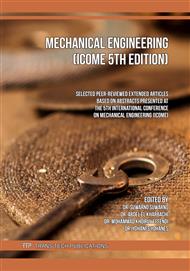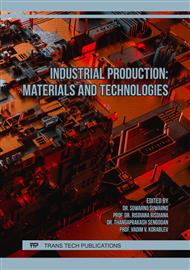[1]
J. Naveen, M. Jawaid, E.S. Zainudin, M.T.H. Sultan, R. Yahaya, Mechanical and moisture diffusion behaviour of hybrid Kevlar/Cocos nucifera sheath reinforced epoxy composites, J Mater Res Technol 8(1), 1308–13018 (2019).
DOI: 10.1016/j.jmrt.2018.07.023
Google Scholar
[2]
M. Bulut, A. Erkliǧ, E. Yeter, Hybridisation effects on quasi-static penetration resistance in fiber reinforced hybrid composite laminates, Compos Part B Eng 98, 9–22 (2016).
DOI: 10.1016/j.compositesb.2016.05.025
Google Scholar
[3]
D. Kumar, R. Kumar, Improvement of mechanical properties of hybrid composites through interply rearrangement of glass and carbon woven fabrics for marine application, Compos Part B 168, 467–475 (2019).
DOI: 10.1016/j.compositesb.2019.03.042
Google Scholar
[4]
J.H. Song, Pairing effect and tensile properties of laminated high-performance hybrid composites prepared using carbon/glass and carbon/aramid fibers, Compos Part B Eng 79, 61–66 (2015).
DOI: 10.1016/j.compositesb.2015.04.015
Google Scholar
[5]
C. Dong, I.J. Davies, Flexural strength of bidirectional hybrid epoxy composites reinforced by e glass and T700S carbon fibers, Compos Part B Eng 72, 65–71 (2015).
DOI: 10.1016/j.compositesb.2014.11.031
Google Scholar
[6]
S.J. Park, H.J. Kim, D.H. Jung, K.Y. Rhee, V. Dhand, G. Mittal, Investigation of seawater effects on the mechanical properties of untreated and treated MMT-based glass fiber/vinyl ester composites, Ocean Eng 108, 393–401 (2015).
DOI: 10.1016/j.oceaneng.2015.08.019
Google Scholar
[7]
E. Sarlin, R. Sironen, T. Pärnänen, M. Lindgren, M. Kanerva, J. Vuorinen, The effect of matrix type on ageing of thick vinyl ester glass-fiber-reinforced laminates, Compos Struct 168, 840–850 (2017).
DOI: 10.1016/j.compstruct.2017.02.086
Google Scholar
[8]
A. Gargano, K. Pingkarawat, V. Pickerd, T. Delaney, R. Das, A.P. Mouritz, Effect of seawater immersion on the explosive blast response of a carbon fiber-polymer laminate, Compos Part A 109, 382–391 (2018).
DOI: 10.1016/j.compositesa.2018.03.027
Google Scholar
[9]
A.M. Visco, N. Campo, P. Cianciafara, Comparison of seawater absorption properties of thermoset resins based composites, Compos Part A 42, 123–130 (2011).
DOI: 10.1016/j.compositesa.2010.10.009
Google Scholar
[10]
A. Boisseau, P. Davies, F. Thiebaud, Sea Water Ageing of Composites for Ocean Energy Conversion Systems : Influence of Glass Fiber Type on Static Behaviour, Appl Compos Mater 19, 459–473 (2012).
DOI: 10.1007/s10443-011-9219-6
Google Scholar
[11]
Y. Hu, X. Li, A.W. Lang, Y. Zhang, S.R. Nutt, Water immersion ageing of polydicyclopentadiene resin and glass fiber composites, Polym Degrad Stab 124, 35–42 (2016).
DOI: 10.1016/j.polymdegradstab.2015.12.008
Google Scholar
[12]
A. Ding, J. Wang, A. Ni, S. Li, Hygroscopic ageing of nonstandard size sandwich composites with vinyl ester-based composite faces and PVC foam core, Compos Struct 206, 194–201 (2018).
DOI: 10.1016/j.compstruct.2018.08.031
Google Scholar
[13]
S. Alessi, G. Pitarresi, G Spadaro, Effect of hydrothermal ageing on the thermal and delamination fracture behaviour of CFRP composites, Compos Part B 67, 145–153 (2014).
DOI: 10.1016/j.compositesb.2014.06.006
Google Scholar
[14]
B. Hong, G. Xian, Ageing of a thermosetting polyurethane and its pultruded carbon fiber plates subjected to seawater immersion, Constr Build Mater 165, 514–522 (2018).
DOI: 10.1016/j.conbuildmat.2018.01.042
Google Scholar
[15]
S.N. Fitriah, M.S.A Majid, M.J.M. Ridzuan, R. Daud, A.G. Gibson, T.A. Assaleh, Influence of hydrothermal ageing on the compressive behaviour of glass fiber/epoxy composite pipes, Compos Struct 159, 350–360 (2017).
DOI: 10.1016/j.compstruct.2016.09.078
Google Scholar
[16]
K.V. Arun, S. Basavarajappa, B.S. Sherigara, Damage characterisation of glass/textile fabric polymer hybrid composites in the seawater environment, Mater Des 31, 930–939 (2010).
DOI: 10.1016/j.matdes.2009.07.029
Google Scholar
[17]
R. Kumar, B. Chandra, Influence of seawater absorption on retention of mechanical properties of nano-TiO2 embedded glass fiber reinforced epoxy polymer matrix composites, Arch Civ Mech Eng 18(4), 1597–1607 (2018).
DOI: 10.1016/j.acme.2018.07.002
Google Scholar



